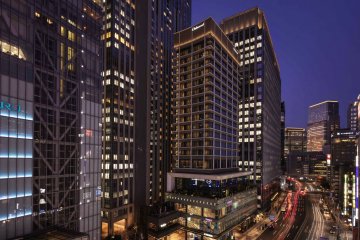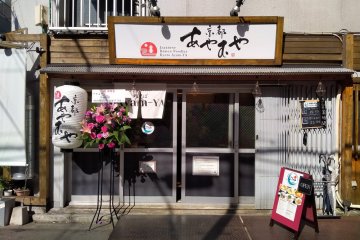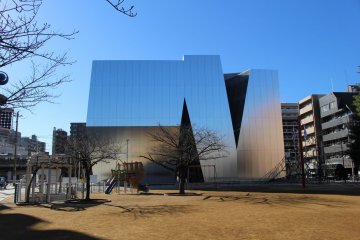
Tokyo Skytree
With a height of 634 meters, the Tokyo Skytree is Japan's tallest structure and a symbol of Tokyo. It is located in the northeastern part of Tokyo. The height of the tower is an allusion to bot...

Tokyo Solamachi is a shopping, dining and entertainment complex at the foot of the famous Tokyo Skytree. It has more than 300 shops and restaurants and is well worth a visit even without the tallest tower in Japan.
There are original Japanese souvenir shops, an official Tokyo Skytree shop, a large food market and food area, as well as many other restaurants and shops that invite you to extensive shopping. Tokyo Solamachi is also home to the Sumida Aquarium, a planetarium and many small green areas and terraces.
The Postal Museum opened in March 2014 on the ninth floor. It has an extensive collection of postage stamps from around the world, as well as interactive exhibits and exhibits that show the history of postal services in Japan.
The Tokyo Solamachi complex is located within steps of Tokyo Skytree Station on the Tobu Skytree line, and a short walk from Oshiage Station on the Toei Asakusa Line. It can also be reached in a 15 minute walk from the popular Asakusa tourist district on the opposite side of the river.

With a height of 634 meters, the Tokyo Skytree is Japan's tallest structure and a symbol of Tokyo. It is located in the northeastern part of Tokyo. The height of the tower is an allusion to bot...

Entrez dans le monde des Moomins, personnages de bandes dessinées de style contes de fées finlandais, au café exclusif "Moomin House Cafe" à Tokyo Skytree Town...

Sumida Aquarium has been bringing aquatic wonders to the Tokyo Skytree area since 2012. The aquarium is a two-floor housing complex for over 10,000 animals. With its artificial seawater system, the...

NOHGA HOTEL AKIHABARA TOKYO is conveniently located in the midst of the electric town Akihabara, also known as the capital of manga and anime. In addition, this neighborhood has an abundance of tech shops, maid cafes and a variety of restaurants. With just a 6-minute walk away from Akihabara station, it provides easy access to explore other areas nearby such as Ueno and Asakusa. This hotel embodies the rich cultures of music, art and food. Nohga’s concept of music is derived from Akihabara’s local history, starting as a district of radio and wireless component merchants in the late 1920s. The artistic and luxurious space throughout the hotel is achieved by featuring art and amenities designed in collaboration with craftsmen from around Japan. As for the food menu, it’s seasonal fresh ingredients are sourced domestically. The glasses and dinnerware served are collaborations with stores in the surrounding area. All 120 non-smoking guest rooms feature an ensuite bathroom with a rain shower, in-room safety box, mini fridge, USB plugs, free Wi-Fi, a high-quality bluetooth speaker and flatscreen TV with original music and film. The lounge area and a compact 24-hour gym can be found near the reception on the second floor. Services include laundry (from 2,750JPY) and a 24-hour front desk with a check-in time of 3PM and check-out time of 11AM. For sightseeing you can rent a Tokyobike for the day (2,000 JPY/day) to explore the vicinity.

Oakwood Premier Tokyo comes from a brand of standout luxury hotel & service apartments right at the heart of the Tokyo metropolis. It is located in the business hub of Marunouchi with JR Tokyo Station in close proximity. This will allow guests and travelers to easily access the city's extensive transport network and visit various landmarks such as Imperial Palace, Tsukiji Fish Market, Ginza and Shopping District. Boasting 123 luxurious apartments on the upper floors of a multi-serviced complex, each room offers a magnificent view of the city, not to mention all furnished and a fully-equipped kitchen set which is rarely seen in your everyday service apartment. Without doubt, these spacious tranquil retreats are curated to give you the amenities and services of a luxury hotel and a feeling of home. They are good options for both business executives and leisure travelers from one night of a short-stay to a few weeks/months of mid-to-long-term stay.

Présentation d'un Hôtel Capsule dans le quartier de Kinshichô à Tokyo.

Ayam-YA is a certified halal ramen restaurant found in the Okachimachi area of Tokyo, between Asakusa and Ueno, and not far from Assalaam Mosque. A sister branch in Kyoto also exists.

Bunny Cafe Moff Rell in Tokyo's Chiyoda Ward offers a chance to interact with adorable rabbits. You can make reservations for the cafe by phone, or you can visit and pay at the store before entering. The cafe provides 30- and 60-minute courses, and you can play with or feed the bunnies. If you are unsure about how to treat the rabbits, don't worry! The staff members will kindly explain everything to you. Minimum age is 10 years old.

PIZZERIA & BAR NOHGA is an all day dining restaurant interpreting a fusion of “Spanish Italian” cuisine and has a kitchen to table design. There is a casual bar area and restaurant where you can take a peek inside the open kitchen whilst enjoying your meal. Visit the cafe for a range of coffees and teas along with an offering of tapas snacks and seasonal desserts. The cafe also offers an assorted dessert and all-you-can-drink cafe set. Breakfast takes on the art of sharing, where a range of platters are combined with focaccia and your choice of eggs cooked your way. Coming for lunch? Choose from a selection of pizzas, pastas and salads. Each lunch menu is accompanied with homemade soup, iced tea and focaccia. Dinner time offers a range of exquisite tapas and pizzas that can also be shared. Breakfast: 07:00 - 10:00, Lunch 11:30 - 14:30, Cafe 14:30 - 18:00, Dinner: 18:00 - 23:00 with last order at 10pm.

The Asakusa Culture Tourist Information Center (浅草文化観光センター, Asakusa bunka kankō sentā) is an eight story building designed by Kengo Kuma. The top floor contains a free observation deck and a cafe with views onto Sensoji temple and the Nakamise shopping street.

Senso-ji Temple (浅草寺, Sensōji) is a popular spot for omikuji, or fortunes. These auspicious sheets are offered in a multitude of languages, enticing both Japanese and foreigners alike to see how their luck plays out. If the number you draw is less than lucky, don’t worry – simply tie up the offending fortune on the nearby wires and allow your bad karma to be spirited away. The temple also shares its grounds with the Asakusa Shrine, dedicated to the three men credited with the temple’s founding. Considered one of the oldest original buildings in Tokyo, the shrine plays host to the exuberant Sanja Matsuri every May. Another popular building (and photo spot) is the five-story pagoda A number of other festivals take place at Senso-ji throughout the year. The Kinryu-no-mai (Dragon Dance) can be enjoyed on March 18th and October 18th, when a large golden dragon on poles is paraded through the streets. Visitors on April 14th can witness the Sagi-no-mai (White Heron Dance), which features a parade of participants in both Heian-era outfits and heron costumes. In late autumn, the temple’s atmosphere grows even more exuberant during its end of the year rake fairs. Buyers come to purchase one of the many colorfully adorned tools in the hopes of raking in good fortune in the coming year. It is arguably one of the most popular tourist destinations in the city, Senso-ji Temple – also known as Asakusa Kannon – can trace its roots back to the early 600s. In 628, two fishermen on the nearby Sumida River repeatedly brought up a golden statue of the Buddhist goddess of mercy along with their usual catch. Finally deciding not to throw the statue back to the depths of the river once more, they instead brought it to their village headman, who convinced them to build a temple in its honor. Senso-ji Temple was finished in the year 645 and quickly became a pilgrimage site. Its popularity endured over the centuries and even continues in the present day, with most visitors making this one of their first stops in Tokyo. The road leading up to the temple, known as the Nakamise-dori or “street of inner shops”, peddles everything from lacquered chopsticks and ukiyo-e prints to cheap keychains and colorful trinkets. Cake-like ningyoyaki¸sweet treats that are served hot off the iron grill, are a popular purchase, as are warming cups of amazake in the winter months.

The Sumida Hokusai Museum (すみだ北斎美術館, Sumida Hokusai Bijutsukan) is a contemporary-style museum dedicated to the life & art of ukiyo-e artist Katsushika Hokusai (1760–1849).